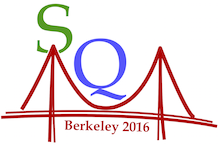Conveners
Vorticity and CVE
- Fuqiang Wang (Purdue University (US))
Iurii Karpenko
(INFN Firenze)
28/06/2016, 16:00
Contributed Talk
We study the formation of collective flow vorticity in non-central heavy ion collisions at RHIC Beam Energy Scan collision energy range, $\sqrt{s_{\rm NN}}=7.7\dots200$ GeV with state-of-the-art viscous hydro model, vHLLE+UrQMD. With the model adjusted to approach the experimental data for rapidity, transverse momentum distributions and elliptic flow of produced hadrons, we explore the...
Long-Gang Pang
(Frankfurt Institute for Advanced Studies, Goethe University)
28/06/2016, 16:20
Contributed Talk
Relativistic hydrodynamics is very successful at describing the dynamical evolution of heavy ion reactions and the quark gluon plasma. In this work the vorticity resulting from fluctuating initial conditions is studied in viscous hydrodynamics. For this purpose, we decompose the fluid velocity vector into curl-free and divergence-free components and find that the evolution consists not only of...
Liwen Wen
(UCLA)
28/06/2016, 16:40
Contributed Talk
QCD allows for chirality imbalance as a consequence of vacuum transition. When coupled with a strong magnetic field produced in heavy-ion collisions, the chirality imbalance in local domains can lead to the electric charge separation along the magnetic field direction, manifested as the chiral magnetic effect (CME). Recently, an analogous effect, the chiral vortical effect (CVE) was also...
Subhash Singha
(Kent State University OH)
28/06/2016, 17:00
Contributed Talk
A goal of the research at the RHIC facility is to study the QCD phase diagram. STAR has
taken Beam Energy Scan (BES) data in order to extend measurements into new regions where the baryon density is high. The beam energy dependence of the slope of directed flow $(dv_{1}/dy)$ for protons and net protons near midrapidity, recently published by STAR, points to a possible softening of the QCD...
Xu-Guang Huang
(Fudan University)
28/06/2016, 17:20
Contributed Talk
We study the event-by-event generation of flow vorticity in RHIC Au + Au collisions and LHC Pb + Pb collisions by using the HIJING model. Different definitions of the vorticity field and velocity field are considered. A variety of properties of the vorticity are explored, including the impact parameter dependence, the collision energy dependence, the spatial distribution, the event-by-event...
Amaresh Jaiswal
(GSI Helmholtzzentrum für Schwerionenforschung)
28/06/2016, 17:40
Contributed Talk
Using a viscosity-based survival scale for geometrical perturbations formed in the early stages of relativistic heavy-ion collisions, we model the radial flow velocity during freeze-out. Subsequently, we employ the Cooper-Frye freeze-out prescription, with first-order viscous corrections to the distribution function, to obtain the transverse momentum distribution of particle yields and flow...
